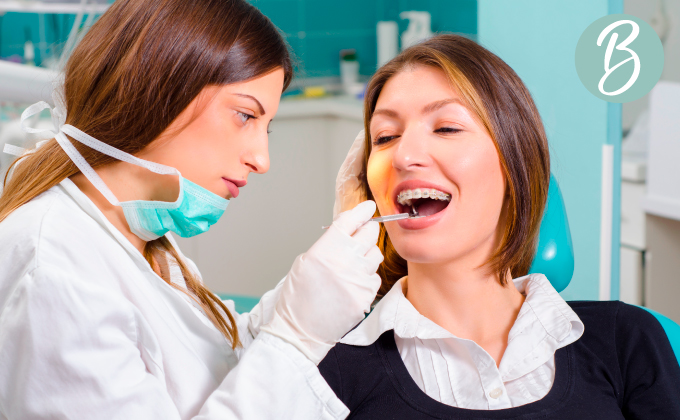What Happens During an Orthodontic Emergency?

Orthodontics plays a crucial role in improving occlusion, the alignment, and positioning of the teeth and jaws. By addressing malocclusions (misalignments), orthodontic treatment helps create a harmonious bite and a balanced facial profile.
Proper occlusion is essential for several reasons. First, it enhances oral function, allowing efficient chewing and biting, which aids in digestion. Additionally, it promotes healthy jaw joint function, reducing the risk of jaw pain and headaches.
Orthodontic treatment aligns the teeth and jaws, correcting issues such as overcrowding, spacing, crossbite, overbite, and underbite. By applying gentle and controlled forces, orthodontic appliances, such as braces or aligners, gradually shift the teeth into their optimal positions.
This realignment improves occlusion, ensuring that the upper and lower teeth fit together correctly, promoting even pressure distribution during biting and chewing.
Moreover, orthodontics contributes to overall oral health. Straighter teeth are easier to clean, reducing the risk of plaque buildup, tooth decay, and gum disease. It can also improve speech clarity, as misalignments can sometimes affect pronunciation.
So, by seeking orthodontic treatment, individuals can achieve improved occlusion, leading to better oral health and function.
What Is Preventive Orthodontic Treatment?
Orthodontic treatment focuses on prevention and intercepting or addressing potential orthodontic issues before they become more severe.
By identifying and correcting early signs of malocclusion or abnormal dental development, preventive orthodontics aims to minimize the need for extensive orthodontic treatment later in life.
Through the use of orthodontic appliances, such as braces or retainers, a preventive treatment can guide the growth and alignment of teeth. But sometimes, these orthodontic appliances can cause discomfort or even ulcerations in the mouth.
It’s important to note that in rare cases, orthodontic emergencies can occur. These emergencies may include a broken wire, a loose bracket, or discomfort due to appliance irritation.
In such situations, it is crucial to contact your orthodontist for assistance promptly. They will provide guidance and arrange for an appointment to address the emergency and ensure your comfort and the integrity of your orthodontic treatment.
What Is Considered an Orthodontic Emergency?
There are two kinds of orthodontic emergencies, minor and major.
Minor Orthodontic Emergencies
A minor orthodontic emergency typically refers to issues that can be temporarily resolved at home or by the patient until they can reach to their dental office.
These include:
- A loose or irritating wire,
- A loose bracket,
- A minor discomfort from braces,
- Or a small orthodontic appliance problem.
Temporary relief measures, such as using orthodontic wax to alleviate irritation or applying gentle pressure to guide a poking wire back into place, can be taken until a professional can fix the issue.
Major Orthodontic Emergencies
On the other hand, a major orthodontic emergency requires immediate attention from an orthodontist to prevent further complications. Examples of major emergencies include:
- Severe pain or injury to the teeth, jaws, or face due to trauma or accident,
- Significant swelling or bleeding in the oral cavity,
- Or a major structural failure of the braces or appliances.
Promptly contacting your orthodontist and seeking urgent dental care in these cases is crucial to ensure proper assessment, treatment, and relief from pain or potential complications.
How to Solve Minor Orthodontic Emergencies at Home?
Some DIY solutions for common minor orthodontic emergencies:
- Loose Wire: Use clean tweezers to gently guide the wire back into place or apply orthodontic wax to secure the loose end.
- Irritating Wire or Bracket: Apply orthodontic wax over the irritating area to provide temporary relief and prevent discomfort.
- Discomfort from Braces: Rinse your mouth with warm saltwater, and take over-the-counter painkillers as directed, and stick to soft foods until the discomfort subsides.
- Poking Wire: Use a pencil eraser to carefully push the poking wire down or apply orthodontic wax to the sharp end.
What Is Orthognathic Surgery and When Is it Medically Necessary?
Orthognathic surgery is a procedure performed by an oral and maxillofacial surgeon to correct significant skeletal abnormalities of the jaws and facial structure. It involves repositioning the upper jaw (maxilla), lower jaw (mandible), or both.
Orthognathic surgery is considered medically necessary when jaw abnormalities significantly impact a person’s ability to chew, speak, breathe, or cause severe facial asymmetry.
It is also recommended when orthodontic treatment alone cannot fully address the underlying skeletal issues.
Though orthognathic surgery is not considered an emergency, it is medically necessary in specific cases.
Quality Orthodontics, Lafayette
Orthognathic surgery (Lafayette) and orthodontic treatment are both available at Balhoff Orthodontics.
Schedule an appointment to meet Dr. Balhoff!

